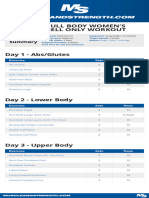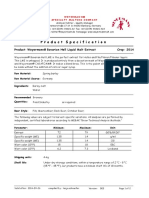0% found this document useful (0 votes)
204 views6 pagesMacro Guide for Fitness Enthusiasts
This document provides instructions on how to calculate macronutrients and determine daily calorie and macro targets for weight loss, maintenance, or muscle gain. It outlines how to use the Mifflin formula to calculate total daily energy expenditure (TDEE) and recommends subtracting 500 calories from the TDEE to calculate a daily calorie goal for weight loss. It then explains how to break down calories into percentages of carbohydrates, proteins, and fats depending on goals. Tracking macros with apps like MyFitnessPal or LoseIt is recommended.
Uploaded by
Austin DormanCopyright
© © All Rights Reserved
We take content rights seriously. If you suspect this is your content, claim it here.
Available Formats
Download as PDF, TXT or read online on Scribd
0% found this document useful (0 votes)
204 views6 pagesMacro Guide for Fitness Enthusiasts
This document provides instructions on how to calculate macronutrients and determine daily calorie and macro targets for weight loss, maintenance, or muscle gain. It outlines how to use the Mifflin formula to calculate total daily energy expenditure (TDEE) and recommends subtracting 500 calories from the TDEE to calculate a daily calorie goal for weight loss. It then explains how to break down calories into percentages of carbohydrates, proteins, and fats depending on goals. Tracking macros with apps like MyFitnessPal or LoseIt is recommended.
Uploaded by
Austin DormanCopyright
© © All Rights Reserved
We take content rights seriously. If you suspect this is your content, claim it here.
Available Formats
Download as PDF, TXT or read online on Scribd
/ 6






































































































